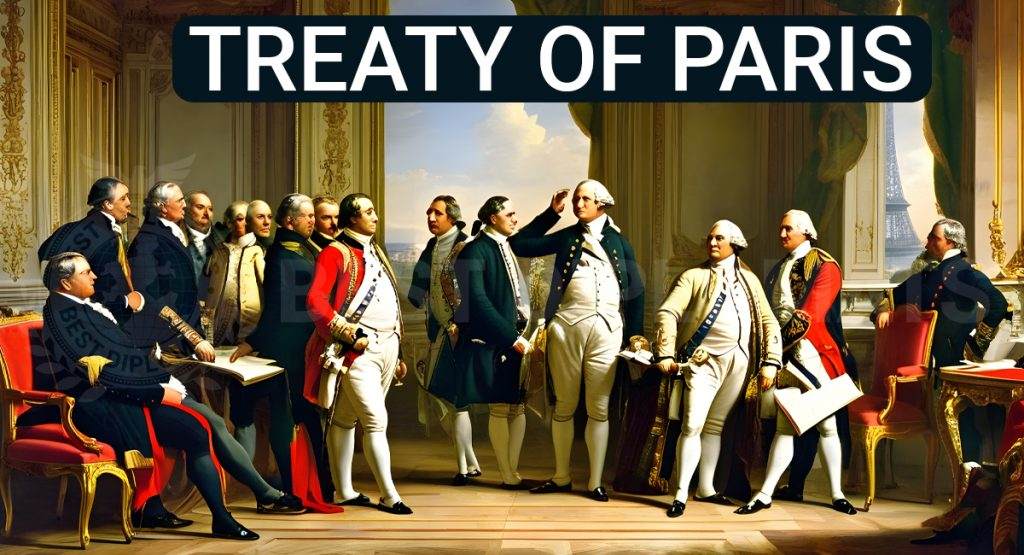In October 1781, the American Revolution reached its climax with the stunning victory at the Battle of Yorktown. Nearly 7,000 British soldiers laid down their arms, and Britain’s grip on North America began to slip. When news reached London, British Prime Minister Lord North famously lamented, “Oh God, it is all over!” But the road to peace was far from smooth. The Treaty of Paris, signed in 1783, not only ended the war but also reshaped the world. Here’s how America’s founding fathers outmaneuvered the British and their European allies to secure independence—and why it still matters today.

The Road to Negotiations: A Game of Chess
By 1782, the British were ready to talk. The war had drained their coffers, and public support was waning. The new British government, led by Prime Minister Lord Rockingham, was eager to end the conflict. But the Americans weren’t the only ones at the table. France, Spain, and the Netherlands had joined the fight against Britain, and each had their own demands.
The American delegation, led by Benjamin Franklin, John Adams, and John Jay, faced a delicate balancing act. They had to secure independence without alienating their French allies, who had bankrolled the revolution. But as negotiations dragged on, it became clear that France’s interests didn’t always align with America’s.
Franklin’s Diplomacy: The Art of the Deal
Benjamin Franklin, America’s elder statesman in Paris, was the face of the revolution in Europe. His charm and wit had won over the French court, but he knew that securing American independence required more than just charisma. Franklin played a subtle game, keeping the French in the dark while secretly negotiating with the British.
When British representative Richard Oswald proposed direct talks, Franklin saw an opportunity. He agreed but set three non-negotiable conditions: Britain must recognize American independence, compensate the U.S. for war damages, and cede Canada. While the British balked at the last two demands, Franklin’s insistence on independence as a precondition set the stage for a favorable deal.
John Jay’s Pragmatism: Cutting Through the Noise
John Jay, the youngest of the American delegates, brought a no-nonsense approach to the negotiations. Unlike Franklin, Jay had little patience for diplomatic niceties. He distrusted the French and believed that America’s future depended on securing the best deal possible, even if it meant going behind France’s back.
Jay’s insistence on clarity paid off. When the British presented a draft treaty referring to America as “colonies,” Jay refused to proceed until the language was changed to “United States.” This seemingly small detail was a huge victory—it forced Britain to formally acknowledge American sovereignty before negotiations even began.
John Adams: The Voice of New England
John Adams, fresh from securing a crucial loan from the Dutch, joined the negotiations in October 1782. His arrival bolstered the American delegation, but it also brought tension. Adams and Franklin had a rocky relationship, with Adams accusing Franklin of being too cozy with the French.
Despite their differences, Adams played a key role in securing one of the treaty’s most important provisions: fishing rights off the coast of Newfoundland. For Adams, this wasn’t just about economics—it was about the survival of New England’s fishing industry. His passionate defense of the issue earned him the nickname “The Atlas of Independence.”
The Treaty’s Key Provisions: A New Nation Emerges
After weeks of intense negotiations, the Treaty of Paris was finalized on November 30, 1782. Its key provisions included:
- Recognition of American Independence: Britain formally acknowledged the United States as a sovereign nation.
- Territorial Expansion: The U.S. gained all land east of the Mississippi River, doubling its size overnight.
- Fishing Rights: American fishermen were granted access to the rich fishing grounds off Newfoundland.
- Debt Repayment: Both sides agreed to honor pre-war debts.
- Loyalist Compensation: Congress “earnestly recommended” that states restore property seized from Loyalists—a provision that was largely ignored.
The French Factor: A Diplomatic Tightrope
The Americans’ decision to negotiate secretly with the British didn’t sit well with their French allies. When Franklin finally informed French Foreign Minister Vergennes of the treaty, Vergennes was furious. But Franklin’s masterful diplomacy—and a timely request for another loan—kept the Franco-American alliance intact.
Legacy and Modern Relevance
The Treaty of Paris didn’t just end a war; it marked the birth of a new nation and set the stage for America’s westward expansion. The negotiations also revealed the complexities of international diplomacy, a lesson that resonates today.
Franklin, Adams, and Jay’s ability to navigate competing interests and secure a favorable deal remains a model of effective diplomacy. Their success reminds us that while alliances are important, a nation’s primary responsibility is to its own people.
As we reflect on the Treaty of Paris, we’re reminded that the fight for independence wasn’t just about breaking free from Britain—it was about building a nation that could stand on its own. And in that, the founding fathers—and mothers—succeeded beyond their wildest dreams.

No comments yet.